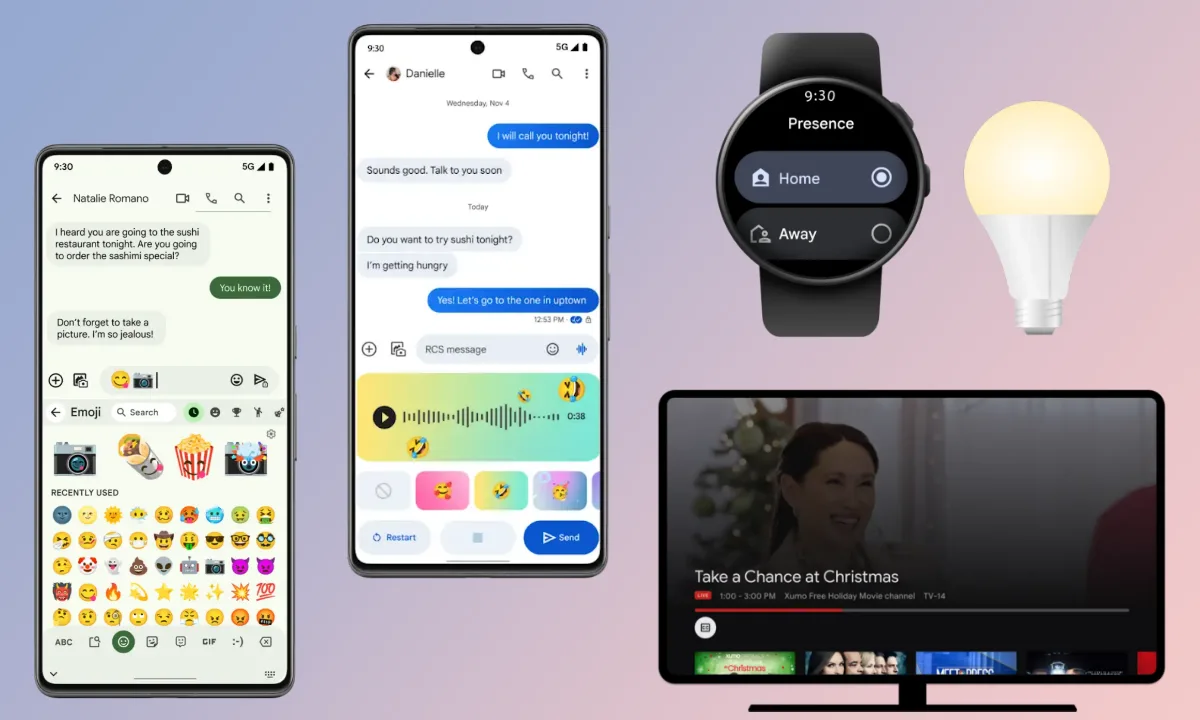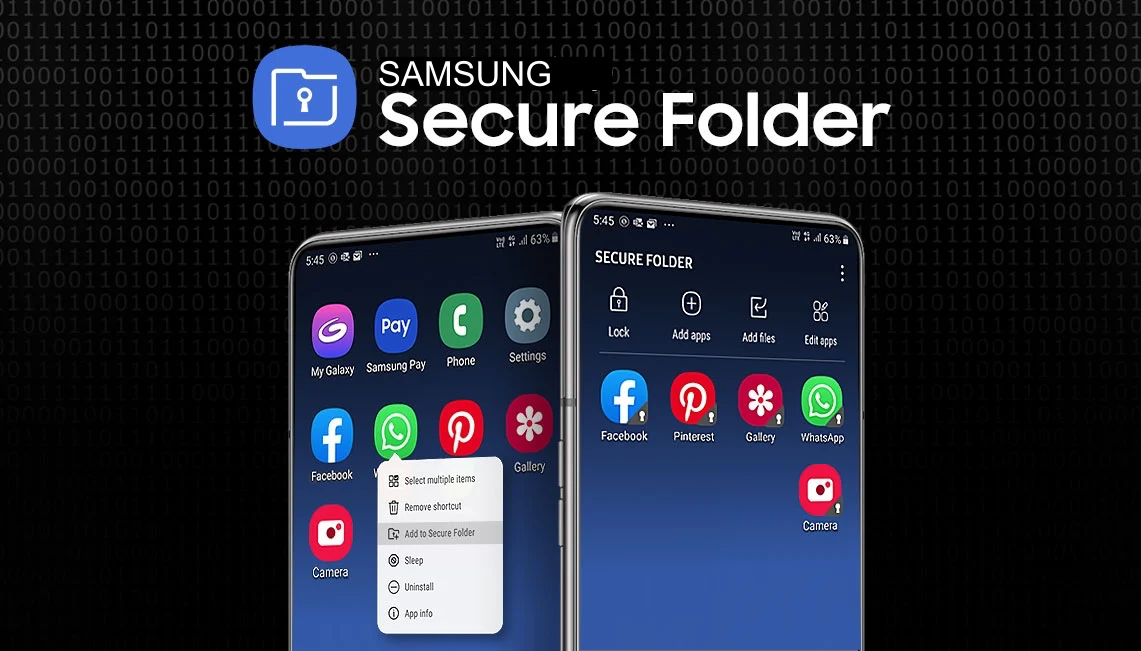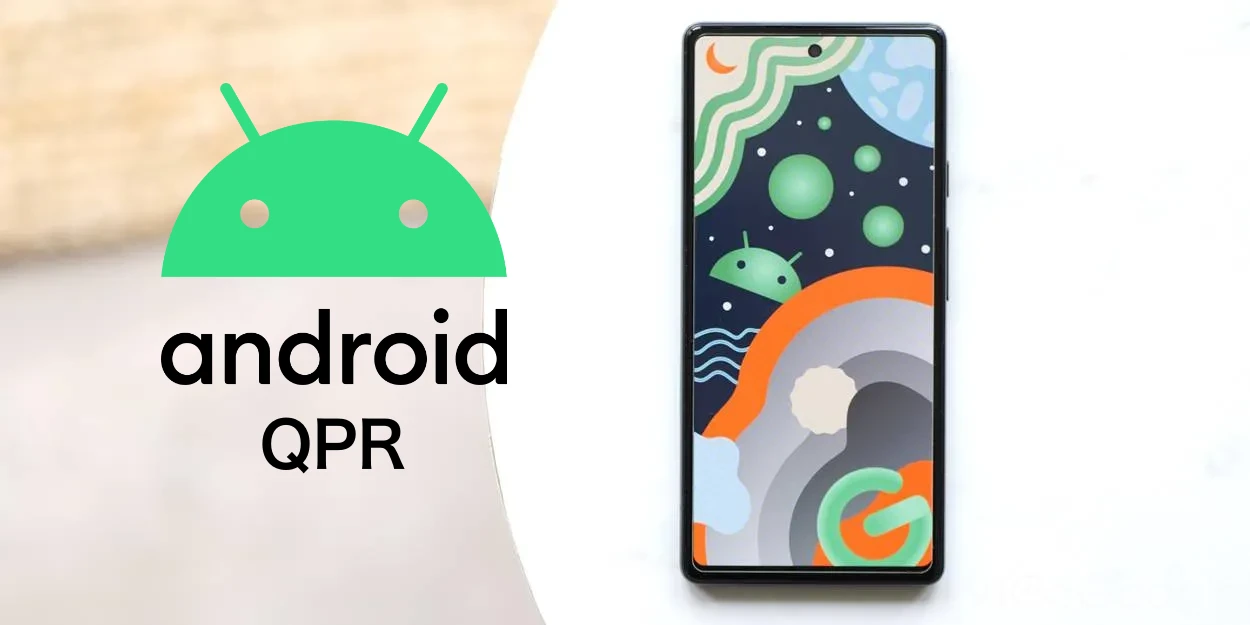Android 14
Google brings 11 new Android Features for Messages, Google TV, Gboard, Emoji, and Wear OS

Android enables you to customize your gadgets to make them more useful, safe, expressive, and accessible. On your smartphone and tablets, Wear OS, wearables, and Google TV devices, you can explore the new features and upgrades, including fresh approaches to using Google Messages. This is the latest on Android. There are new features in this Android Feature Drop that work with Google Messages, Google Home on Wear OS, Google TV, Gboard and its Emoji Kitchen, TalkBack, and what seems like a highly entertaining New Live Caption concept.
- Rejoice with fresh combinations of Emoji Kitchen stickers:
Your favorite emojis may be remade and then shared as Gboard stickers with friends. There are more ways to express what’s on your mind, whether you’re preparing supper for guests or have the ideal idea for a photo. Creating and sharing a camera emoji that is combined with a tongue-out happy smile emoji on an Android phone using Emoji Kitchen Create unique sticker combinations by combining your preferred emojis.

- Use Voice Moods to Show While You Tell:
Google Messages (beta) Voice Moods gives your voice messages a distinctive background and a dynamic emoji theme. You can more effectively convey your emotions in the present, whether you’re shocked, laughing, or feeling loved. To let people know how you’re feeling, include visual themes in your voice messages.

- Use Google Messages to communicate with more impact:
A full-screen animated emoji is shown for everyone to see when the standard thumbs up simply won’t do in Google Messages. Talk more animatedly and express to your friends your true levels of excitement, astonishment, and confusion.
- Use Google TV to get over ten additional free TV stations:
Google TV now offers over ten additional free channels, making it simpler to discover new favorites and watch the episodes you enjoy. Don’t worry about juggling several subscriptions; discover over 100 different free channels, including movie, sports, and game show networks. Look through Google TV’s more than 115 complimentary channels.

- Use your smartwatch to operate other smart home appliances and light groups.
You can now use your Wear OS smartwatch to activate and dock compatible smart appliances, like vacuums and mop sticks, thanks to additional controls for compatible devices. Controlling light groups for supper, study time, and anything in between may help instantly establish the tone. Using your wristwatch, you can simultaneously control several lights.

- Indicate to your smart home appliances whether you’re at home or away:
Verify that the functions of your smart home appliances are meeting your needs at the appropriate times. With the help of your Wear OS wristwatch, you can now quickly adjust your Google Home status to Home or Away, ensuring that your lights, doors, and cameras are secured and switched off while you’re away.

- Use Wear OS Assistant Routines to streamline everyday operations:
To help you do more while on the road, Assistant Routines will soon be available for voice command access directly from your Wear OS wearable.
- Streamline the process of using a security key to log in.
For websites or applications that ask for user verification, you may now establish a personalized PIN on your FIDO2 security keys, which will let you log in without having to remember awkward passwords. Your information will not be compromised in the event that your physical key is misplaced or stolen, since only your unique PIN number will be needed to access your credentials.
- Use your assistant to help you organize your day.
No matter where your Wear OS smartwatch takes you, get what you need when you need it. The recently appointed Assistant Important information, such as travel updates, weather warnings, and event reminders, is shown on your wrist thanks to the At a Glance shortcut on your watch face.
- Listen to AI explanations of images:
Individuals with limited vision and blindness may have to make educated guesses about the meaning of images in the absence of reliable written explanations. Whether it’s a photograph you just snapped, an image from an app or social networking platform, or a picture message from a friend, TalkBack now utilizes AI to build a description and read it out.
- Use live captioning to answer calls and access media.
Calls and media stored on devices are now easier to access. More languages will be added to Live Caption throughout the course of the next few weeks. It’s also going to be possible to text a response to a phone call while it’s still in progress, which means you won’t have to hear the caller or answer vocally.
Android 14
Galaxy XCover5 camera breaks after Android 14 and One UI 6.0 update

Samsung Galaxy XCover 5 is one of the rugged smartphones that is dedicatedly made for using it in any weather condition. It is worth noticing that the company hasn’t limited it to giving tough hardware but also keeps it up to date with its fresh software. In the last major update, Android 14, it has grabbed some new features, and unfortunately, it has also got an issue with the camera, which is causing inconvenience to the users.
Galaxy XCover5 getting a camera issue after Android 14
The Galaxy XCover 5 has received Android 14 and One UI 6.0, and after installing them, users have started reporting about the camera issue. In the reports, the consumers have pointed out that they are not able to use the camera focus like before. Since the camera is the most frequently used feature of the smartphone, its malfunction is significantly affecting the overall performance of the devices.
Due to the malfunctioning of the autofocus, users are also having difficulty making payments due to the autofocus malfunction. When they open the QR code scanner, they are unable to do so because the camera is not focusing on the code.
However, the Korean giant hasn’t yet released a statement regarding the issue’s resolution, despite the fact that the issue surfaced after the last update, suggesting a software update-related problem. Hopefully, Samsung could release a proper update that will update it to the latest version.
Android 14
Google Get Inspired By Samsung; As It Copies Secure Folder Feature Housed In Galaxy Phones

Is Google following Samsung? With the Android 14 QPR3 Beta 2.1, it offers a new option for private space, which Samsung already offers with the title Secure Folder.
Google released Android 14 QPR2 Beta 1 in November 2023, which introduced a feature called ‘Private Space’ already housed in Samsung devices as Secure Folder. Since reports have been around for several days that the latest iteration of Android 15 will be dedicated to more security and will bring tons of new features to enhance users’ secure experiences, one of the awaiting features is Private Space.
The upcoming Private Space feature will allow the user to install the application in a separate, locked profile, which they can hide at any time. Although this feature has been in the development phase for a long time, it has not yet gone live. Let’s take a closer look.

The new feature named ‘Lock private space automatically’ will allow users to configure the feature to automatically lock the protected space depending on one of the two sub-options they select in it, which are ‘Every time device lock’ and ‘After 5 minutes of inactivity.’ While choosing the first, the feature will lock Privact Space instantly after they lock the device.
But here’s the catchable fact: Secure Folder, available on Galaxy devices, already offers this feature, so somewhere it seems like Google got inspired by Samsung.

The reports are also saying that when users set up Private Space, the feature now recommends them to create a dedicated Google account for using it to’stop data appearing outside private space; for instance, ‘Synced photos, files, emails, contacts, calendar events, and other data,’ and many more. This suggestion and the option to automatically lock the protected space further enhance the privacy and security of private space.
Upcoming Private Space will offer a redesign setup flow to deliver a better idea of the feature. Since this feature initially appeared in Android 14 QPR2 Beta 1 and then Android 14 QPR3 Beta 2.1, it is expected that Android 15 will bring this feature to enhance the secure experience.
Android 14
Android 14 QPR3 Beta 2.1 Now Available

Google is preparing for its second-pixel drop update for this year. To develop it, the company has already started the Android 14 QPR3 Beta updates. Now, moving forward, it has started rolling out the Beta 2.1 updates, while earlier it rolled out two more beta updates, including Beta 1 and Beta 2, which brought several fixes.
Android 14 QPR 3 2.1 beta update: What’s New
The Android 14 QPR3 beta 2.1 is now available for Pixel devices. It is carrying the firmware version number AP21.240305.005. It is still using the March 2024 patch for security, but now it is live for all the eligible Pixel devices, including the Pixel 5a, Pixel 6, Pixel 6 Pro, Pixel 6a, Pixel 7, Pixel 7 Pro, Pixel 7a, Pixel Tablet, Pixel Fold, Pixel 8, and Pixel 8 Pro. With the latest update, several issues have been fixed, which will surely improve the overall experience of the devices.
With the latest update, there are several problems related to the UI that have been solved. This includes a launcher crash, a charging issue in the Pixel tablet, the home screen, the layout of notifications, wallpaper settings, ‘Quick tap to start actions’ gesture functionality, and many more.
Along with this, the update changelog also shares information about the top open issues and some common issues related to the Android platform and Google apps. For more details, check out the full changelog below.
Android 14 QPR 3 Beta 2.1 changelog
- Fixed an issue that sometimes caused a device’s launcher to crash when trying to view recent apps. (Issue #328803294)
- Fixed an issue that sometimes prevented Pixel Tablet devices from charging while connected to the dock. (Issue #299800125)
- Fixed an issue where swiping up from the bottom of the screen didn’t always return to the home screen.
- I fixed an issue that caused the layout of notifications on the lock screen to display with additional padding.
- Fixed various issues that were causing frequent “Application not responding” errors for both system and user apps.
- Fixed an issue where swiping down from the top of the screen didn’t always show the notification shade.
- Fixed an issue for Pixel Fold devices where sometimes, when the device was unfolded, only half of the inner screen displayed content.
- Fixed an issue that sometimes prevented a user’s wallpaper settings from being backed up properly.
- Fixed an issue that sometimes stopped the “Quick Tap to Start Actions” gesture from working.
- Fixed various other issues that were impacting system stability, performance, connectivity, interactivity, and camera
Top open issues
See Top Open Issues for the latest list of issues that have been reported by developers.
Other known issues
Based on our testing, you might encounter the following issues when using Android 14 QPR3 Beta 2.1: These issues are already known, so there’s no need to file additional reports for similar issues.
Android platform
- An issue with sideloading the Beta 2 build can sometimes cause a device to fail to boot properly after sideloading is completed. Due to the potential disruption that this issue can cause, we’ve temporarily disabled downloads for OTA images until we can further troubleshoot the issue. To work around this issue, we recommend that developers flash a factory image to test devices instead.
Google apps
- The Assistant The Glance widget sometimes displays weather information for the wrong location.








